Asclepias
| Asclepias | |
|---|---|
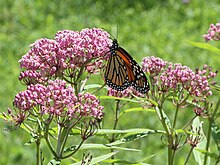
| |
| Asclepias incarnata (swamp milkweed) flowers and a monarch butterfly | |
| Scientific classification | |
| Kingdom: | Plantae |
| Clade: | Tracheophytes |
| Clade: | Angiosperms |
| Clade: | Eudicots |
| Clade: | Asterids |
| Order: | Gentianales |
| Family: | Apocynaceae |
| Subfamily: | Asclepiadoideae |
| Tribe: | Asclepiadeae
|
| Subtribe: | Asclepiadinae |
| Genus: | Asclepias L.[1] |
| Type species | |
| Asclepias syriaca L.
| |
| Species[2] | |
| Synonyms[3] | |
|
List
| |
Asclepias is a
The genus contains over 200 species distributed broadly across Africa, North America, and South America.[7] It previously belonged to the family Asclepiadaceae, which is now classified as the subfamily Asclepiadoideae of the dogbane family, Apocynaceae.
The genus was formally described by Carl Linnaeus in 1753,[8] who named it after Asclepius, the Greek god of healing.[9]
Flowers




Members of the genus produce some of the most complex flowers in the plant kingdom, comparable to


Asclepias species produce their seeds in pods termed
Selected species
| Image | Scientific name | Common name | Distribution |
|---|---|---|---|
 |
Asclepias albicans | Whitestem milkweed | Native to the Mojave and Sonoran deserts |
 |
Asclepias amplexicaulis | Blunt-leaved milkweed | Native to central and eastern United States |
 |
Asclepias asperula | Antelope horns | Native to American southwest and northern Mexico
|
 |
Asclepias californica | California milkweed | Native to central and southern California |
 |
Asclepias cordifolia | Heart-leaf milkweed | Native to the Sierra Nevada and Cascade Range up to 2,000 m (6,600 ft).
|
 |
Asclepias cryptoceras | Pallid milkweed | Native to the western United States. |
 |
Asclepias curassavica | Scarlet milkweed, tropical milkweed, bloodflower, bastard ipecacuanha | Native to the American tropics, introduced to other continents |
 |
Asclepias curtissii | Curtiss's milkweed | Endemic to sandy areas of Florida |
 |
Asclepias eriocarpa | Woollypod milkweed | Native to California, Baja California, and Nevada |
 |
Asclepias erosa | Desert milkweed | Native to California, Arizona, and Baja California |
 |
Asclepias exaltata | Poke milkweed | Native to eastern North America |
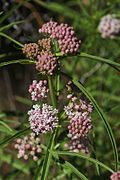 |
Asclepias fascicularis | Narrow-leaf milkweed | Native to Western United States |
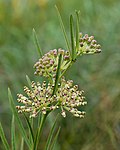 |
Asclepias hirtella | Tall green milkweed | |
 |
Asclepias humistrata | Sandhill milkweed | Native to southeastern United States |
 |
Asclepias incarnata | Swamp milkweed | Native to wetlands of North America |
 |
Asclepias lanceolata | Lanceolate milkweed (Cedar Hill milkweed) | Native to coastal plain of eastern United States from Texas to New Jersey |
 |
Asclepias linaria | Pine needle milkweed | Native to Mojave and Sonoran deserts |
 |
Asclepias meadii | Mead's milkweed | Native to midwestern United States |
 |
Asclepias nyctaginifolia | Mojave milkweed | native to the American southwest |
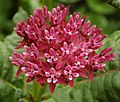 |
Asclepias purpurascens | Purple milkweed | Native to eastern, southern, and midwestern United States |
 |
Asclepias prostrata | Prostrate milkweed | Native to Texas and northern Mexico |
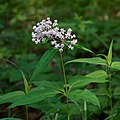 |
Asclepias quadrifolia | Four-leaved milkweed | Native to eastern United States and Canada |
 |
Asclepias rubra | Red milkweed | |
 |
Asclepias solanoana | Serpentine milkweed | Native to northern California |
 |
Asclepias speciosa | Showy milkweed | Native to western United States and Canada |
 |
Asclepias subulata | Rush milkweed | Native to southwestern North America |
 |
Asclepias subverticillata | Horsetail milkweed[14] | |
 |
Asclepias sullivantii | Sullivant's milkweed | |
 |
Asclepias syriaca | Common milkweed | |
 |
Asclepias texana | Texas milkweed | |
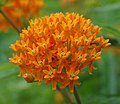 |
Asclepias tuberosa | Butterfly weed, pleurisy root | |
 |
Asclepias uncialis | Wheel milkweed | |
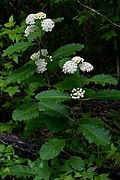 |
Asclepias variegata | White milkweed | |
 |
Asclepias verticillata | Whorled milkweed | |
 |
Asclepias viridiflora | Green milkweed | |
 |
Asclepias viridis | Green antelopehorn, spider milkweed | |
 |
Asclepias welshii | Welsh's milkweed |
There are also 12 species of Asclepias in South America, among them: A. barjoniifolia, A. boliviensis, A. curassavica, A. mellodora, A. candida, A. flava, and A. pilgeriana.
Ecology
Milkweeds are an important
Milkweeds use three primary defenses to limit damage caused by caterpillars: hairs on the leaves (trichomes), cardenolide toxins, and latex fluids.[16] Data from a DNA study indicate that, generally, more recently evolved milkweed species ("derived" in botany parlance) use these preventive strategies less but grow faster than older species, potentially regrowing faster than caterpillars can consume them.[17][18][19]
Research indicates that the very high
Monarch butterfly conservation and milkweeds
The leaves of Asclepias species are a food source for
However, some milkweed species are not suitable for butterfly gardens and monarch waystations. For example, A. curassavica, or tropical milkweed, is often planted as an ornamental in butterfly gardens outside of its native range of Mexico and Central America. Year-round plantings of this species in the United States are controversial and criticised, as they may lead to new overwintering sites along the U.S. Gulf Coast and the consequent year-round breeding of monarchs.[22] This is thought to adversely affect migration patterns, and to cause a dramatic build-up of the dangerous parasite, Ophryocystis elektroscirrha.[23] New research also has shown that monarch larvae reared on tropical milkweed show reduced migratory development (reproductive diapause), and when migratory adults are exposed to tropical milkweed, it stimulates reproductive tissue growth.[24]
Because of this, it is most often suggested to grow milkweeds that are native to the geographical area they are planted in to prevent negative impacts on monarch butterflies.[25][26]
Monarch caterpillars do not favor butterfly weed (A. tuberosa), perhaps because the leaves of that milkweed species contain very little cardenolide.[27] Some other milkweeds may have similar characteristics.
Uses
Milkweeds are not grown commercially in large scale, but the plants have had many uses throughout human history.[5] Milkweeds have a long history of medicinal, every day, and military use. The Omaha people from Nebraska, the Menomin from Wisconsin and upper Michigan, the Dakota from Minnesota, and the Ponca people from Nebraska, traditionally used common milkweed (A. syriaca) for medicinal purposes.[citation needed] The
The fine, silky fluff attached to milkweed seeds, which allows them to be distributed long distances on the wind, is known as floss. Milkweed floss is incredibly difficult to spin due to how short and smooth the filaments are, but blending it with as little as 25% wool or other fiber can produce workable yarn.[29]
A study of the insulative properties of various materials found that milkweed floss was outperformed by other materials in terms of insulation, loft, and lumpiness, but it scored well when mixed with down feathers.[30] The milkweed filaments from the coma (the "floss") are hollow and coated with wax, and have good insulation qualities. During World War II, more than 5,000 t (5,500 short tons) of milkweed floss was collected in the US as a substitute for kapok.[31][32] Milkweed is grown commercially as a hypoallergenic filling for pillows[33] and as insulation for winter coats.[34] Using milkweed floss for these purposes could provide a plant-based alternative to down and promote the growth of milkweed in areas where it has declined, though there is some concern that the environmental impacts could be negative if monoculture is used.[35] Asclepias is also known as "Silk of America"

Milkweed latex contains about two percent latex, and during World War II both Nazi Germany and the US attempted to use it as a source of natural rubber, although no record of large-scale success has been found.[41]
Many milkweed species also contain
References
- ^ "Taxon: Asclepias L." Germplasm Resources Information Network. United States Department of Agriculture. 2003-03-13. Retrieved 2013-02-05.
- ^ "Asclepias". NCBI taxonomy. Bethesda, MD: National Center for Biotechnology Information. Retrieved 10 August 2018.
- ^ "Asclepias L. | Plants of the World Online | Kew Science". Plants of the World Online. Retrieved 2024-02-12.
- .
- ^ ISBN 9781400884766.
- ^ PMID 22292897.
- Royal Botanical Gardens, Kew. Retrieved 2018-11-23.
- ^ "Asclepias". ipni.org. International Plant Names Index. Retrieved 2018-11-23.
- ISBN 978-0-8493-2673-8.
Latin asclepias and Greek asklepias for the common swallowwort; Asclepius, Greek god of medicine, the worship of Asclepius was centered in Epidaurus. See W.K.C. Guthrie, The Greeks and Their Gods, 1950; Carl Linnaeus, Species Plantarum. 214. 1753 and Genera Plantarum. Ed. 5. 102. 1754.
- ^ http://orbisec.com/milkweed-flower-morphology-and-terminology/ Milkweed Flower Morphology
- ^ a b Robertson, C. (1887) Insect relations of certain asclepiads. I. Botanical Gazette 12: 207–216
- ^ Ollerton, J. & S. Liede. 1997. Pollination systems in the Asclepiadaceae: a survey and preliminary analysis. Biological Journal of the Linnean Society (1997), 62: 593–610.
- ^ Sacchi, C.F. (1987) Variability in dispersal ability of Common Milkweed, Asclepias syriaca, seeds, Oikos Vol. 49, pp. 191–198
- ^ Asclepias subverticillata (A. Gray) Vail, USDA PLANTS
- JSTOR 1934896.
- OCLC 918150494.
- ^ Ramanujan, Krishna (Winter 2008). "Discoveries: Milkweed evolves to shrug off predation". Northern Woodlands. 15 (4): 56.
- PMID 18645183.
- S2CID 34282179.
- ^ "We're losing monarchs fast—here's why". Animals. 2018-12-21. Archived from the original on February 24, 2021. Retrieved 2022-12-01.
- ^ (1) "Butterfly Gardening: Introduction". University of Kansas: Monarch Watch. Archived from the original on 2 February 2020. Retrieved 9 March 2020.
(2) "Monarch Watch: Monarch Waystation Program". University of Kansas, Entomology Department. Archived from the original on 18 Nov 2019. Retrieved 26 February 2019.
(3) "Monarch Garden Plants" (PDF). San Francisco, California: Pollinator Partnership. Archived from the original (PDF) on 9 March 2020. Retrieved 9 March 2020. - .
- PMID 25589600.
- PMID 31426310.
- ^ "Milkweed for Monarchs". The National Wildlife Federation.
- ^ "Milkweed Map - discover native milkweed". GROW MILKWEED PLANTS. Retrieved 2022-04-10.
- doi:10.1002/ecs2.2064.(PDF) from the original on September 11, 2020. Retrieved September 11, 2020.
In our study, the least preferred milkweed species A. tuberosa (no choice; Fig. 2) and A. verticillata (choice; Fig. 3A) both have low cardenolide levels recorded in the literature (Roeske et al. 1976, Agrawal et al. 2009, 2015, Rasmann and Agrawal 2011)
(2) Abugattas, Alonzo (3 January 2017). "Monarch Way Stations". Capital Naturalist. Archived from the original on 5 June 2017. Retrieved 5 June 2017 – via Blogger.It is the least favored by monarch caterpillars though because it has very little toxin (cardiac glycosides) in its leaves, but other butterflies and adult monarchs love it as a nectar source.
.
(3) "Butterfly Weed: Asclepias tuberosa" (PDF). Becker County, Minnesota: Becker Soil and Water Conservation District. ArchivedUnlike other milkweeds, this plant has a clear sap, and the level of toxic cardiac glycosides is consistently low (although other toxic compounds may be present).
. - ISBN 9781081170653.
- ^ Nehring, Julia. "The potential of milkweed floss as a natural fiber in the textile industry" (PDF). Center for Undergraduate Research.
- S2CID 17783131.
- ^ Hauswirth, Katherine (2008-10-26). "The Heroic Milkweed". The Christian Science Monitor. Retrieved 2014-02-14.
- ^ Wykes, Gerald (2014-02-04). "A Weed Goes to War, and Michigan Provides the Ammunition". MLive Media Group. Michigan History Magazine. Retrieved 2014-02-14.
- .
- ^ Bernstein, Jaela (2016-10-13). "How a Quebec company used a weed to create a one-of-a-kind winter coat". CBC News. Retrieved 2018-01-05.
- ^ Bauck, Whitney (23 January 2020). "THE FUTURE OF SUSTAINABLE MATERIALS: MILKWEED FLOSS". Fashionista.com.
- ^ Charles Sigisbert, Sonnini (1810). Traité de l'asclépiade.
- ^ Augustine, Kathy. "Monarchs, Milkweed, and You". spinoffmagazine.com. Spin Off Magazine.
- .
- ^ "La soie d'Amérique passe en production industrielle". Radio Canada. Retrieved 20 December 2015.
- ^ "Milkweed touted as oil-spill super-sucker — with butterfly benefits". cbc.ca. 2 December 2014.
- ^ Beckett, R. E.; Stitt, R. S. (May 1935). The desert milkweed (Asclepias subulata) as a possible source of rubber (Technical report). United States Department of Agriculture. 73.
- Everitt, J.H.; Lonard, R.L.; Little, C.R. (2007). Weeds in South Texas and Northern Mexico. Lubbock: Texas Tech University Press. ISBN 0-89672-614-2
